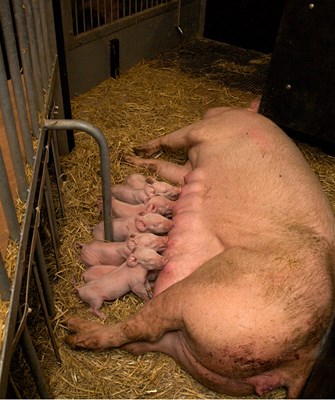Soon after they are born, the teeth of piglets are often clipped.
The purpose of teeth-clipping is to reduce injuries caused to each other and to their mother as piglets nurse. However, there are higher welfare alternatives to reduce injuries.
Why are piglets born with sharp incisor teeth?
Sows do not always have enough milk to feed all of their piglets, especially if they have large litters. To ensure that at least some of the piglets survive, the strongest get preferential treatment.
The teats closest to the front of a sow’s body get the most milk. The teats toward the back of the body get progressively less.
Piglets are born with sharp incisor teeth to fight for the best teats. Once a piglet has established ownership of a teat, he or she will vigorously defend it.
Fighting for teats is most severe if the sow does not have enough milk for all of her piglets. This can happen if the sow has more piglets than she can look after, if she is in poor health, or if for some reason she eats too little food.
Can injuries be reduced without teeth-clipping?

Breeding sows to produce smaller litters can reduce injuries caused by fighting for teats. This can also reduce the number of piglets who will starve, provided the sow is properly fed. Some breeds have higher levels of fat, and this can help them to maintain adequate levels of milk.
Keeping the sow in high-welfare farrowing systems may also help. Research in Denmark has found that sows in free-farrowing systems ate more food than those kept in crates, and it was suggested that they were likely producing more milk. Piglets in the free-farrowing systems grew better and were heavier at weaning than those in crates.
This may explain why there are fewer injuries to the sow’s teats and to piglets in systems with plenty of space and enrichments such as straw.
Warning: watching this clip may be distressing
There are no US laws restricting teeth-clipping, but it is prohibited by both the Animal Welfare Approved program and Global Animal Partnership’s 5-Step welfare standards. European Union rules mandate that modifications to the environment and stocking density should be attempted before resorting to teeth clipping.
Want to help farmed animals? Visit our action center.

